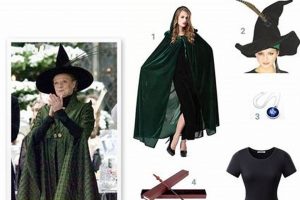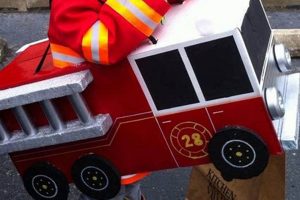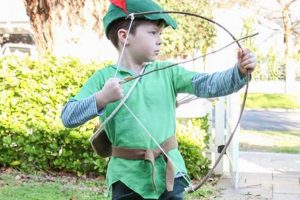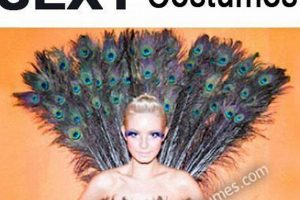Creating a spotted canine-themed outfit at home involves designing and assembling attire that mimics the appearance of a Dalmatian dog. This often entails crafting or modifying clothing and accessories, featuring white fabric adorned with black spots, to resemble the breed’s distinctive markings. For example, individuals might fashion a hooded sweatshirt with felt spots glued onto it to serve as a simple, homemade garment.
The appeal of constructing such an outfit stems from its affordability and the opportunity for personalization. Rather than purchasing a pre-made item, individuals can tailor the design to specific preferences and body types, fostering creativity and resourcefulness. Historically, this type of project aligns with a broader trend of crafting personalized costumes, particularly for festive occasions, reflecting a desire for unique expression and cost-effective alternatives.
The following sections will explore various techniques for spot application, material choices, and construction methods to facilitate the successful creation of a homemade spotted canine-inspired ensemble. It will also provide guidance on adapting existing garments and crafting accessories to complete the desired look.
Tips for a Superior Dalmatian Costume
Achieving a convincing and durable spotted canine representation requires careful planning and execution. The following tips offer guidance to ensure a high-quality, homemade result.
Tip 1: Fabric Selection is Paramount. Opt for durable, washable fabrics such as fleece or cotton blends. These materials provide a comfortable base and can withstand repeated application of spots and general wear.
Tip 2: Spot Application Techniques Matter. Consider using felt, fabric paint, or iron-on vinyl for creating the spots. Felt provides a textured appearance, while fabric paint offers a smooth, permanent finish. Iron-on vinyl allows for precise spot shapes and secure adhesion.
Tip 3: Spot Size and Placement Should Vary. Replicate the natural appearance of Dalmatian markings by using a variety of spot sizes and distributing them unevenly across the garment. Avoid perfectly symmetrical patterns for a more authentic look.
Tip 4: Prioritize Comfort and Mobility. Ensure the costume allows for unrestricted movement. Choose breathable fabrics and avoid overly tight or restrictive designs. Consider the wearer’s age and planned activities when designing the costume.
Tip 5: Secure All Attachments. Whether gluing, sewing, or ironing on spots, ensure they are securely attached to prevent them from detaching during wear. Reinforce seams and adhesive bonds as necessary.
Tip 6: Incorporate Accessories for Enhanced Realism. Consider adding accessories such as a tail, ears, or a collar to complete the ensemble. These additions can significantly enhance the costume’s overall effect.
Tip 7: Test the Costume Before the Event. Conduct a trial run of the costume to identify any potential issues with fit, comfort, or durability. This allows for necessary adjustments before the final event.
By following these recommendations, the creation of a visually appealing and structurally sound homemade spotted canine outfit is significantly more achievable. Attention to detail and adherence to proven techniques are crucial for a successful outcome.
The subsequent section will delve into specific design ideas and variations for creating unique and memorable spotted canine-inspired ensembles.
1. Fabric selection criteria
The successful construction of a homemade spotted canine outfit relies significantly on the appropriate selection of materials. Fabric choice directly impacts the costume’s visual appeal, comfort, durability, and ease of construction. Inadequate fabric selection can result in a finished product that is uncomfortable, prone to damage, or aesthetically unconvincing. For example, using a non-breathable synthetic fabric can cause discomfort during extended wear, particularly in warm environments. Conversely, a delicate fabric may not withstand the application of spots or the rigors of active use.
Specific criteria for fabric selection include fiber content, weight, weave, and colorfastness. A common approach involves selecting fleece for its softness, warmth, and ease of manipulation, allowing it to serve as a cost-effective and comfortable option. The effectiveness of spot application methods, whether painting, gluing, or sewing, is directly influenced by the fabric’s texture and composition. Durable fabrics, such as cotton blends, are often selected for their ability to withstand repeated washing and abrasion. The colorfastness property of the chosen fabric is paramount to prevent bleeding or fading, especially during cleaning processes.
In summary, fabric selection represents a crucial step in producing a satisfactory and enduring homemade spotted canine creation. Appropriate fabric selection involves balancing comfort, durability, visual appeal, and ease of manipulation for optimized results. Failure to address these criteria may result in a substandard and unsatisfactory output.
2. Spot application methods
Spot application methods constitute a critical determinant of both the visual fidelity and longevity of a spotted canine-themed outfit. The chosen technique directly influences the authenticity of the representation and the costume’s ability to withstand repeated wear and washing. For example, a poorly executed application, such as using low-quality adhesive for felt spots, can result in spots detaching during use, compromising the costume’s appearance and structural integrity. Conversely, robust methods, like fabric painting or secure sewing, enhance the costume’s durability and maintain its aesthetic appeal over time.
The practicality of different application methods varies depending on the fabric type, the desired aesthetic, and the available resources. Fabric paint offers a permanent and smooth finish but requires precision and skill to avoid smudging or uneven coverage. Felt spots provide a textured appearance and are relatively easy to apply using adhesive or stitching. Iron-on vinyl provides clean edges and a secure bond but necessitates specialized equipment and careful adherence to manufacturer instructions. Consider the scale of production. The larger the spotted canine-themed outfit being produced, the more automated and efficient the methods should be to remain effective and economical.
In summary, selecting an appropriate spot application technique is paramount for achieving a high-quality spotted canine ensemble. Considerations include the desired aesthetic, the durability requirements, the fabric properties, and the available tools and skills. Understanding the strengths and limitations of each method enables informed decision-making, directly contributing to a satisfactory and lasting result. These choices contribute to the overall success and
impact of the costume, reinforcing the significance of careful planning and execution.
3. Pattern accuracy considerations
Pattern accuracy is a critical determinant in the successful creation of a visually convincing and functionally appropriate spotted canine-themed outfit. Deviations from precise pattern specifications can result in a final product that lacks proper fit, proportion, and overall aesthetic appeal, thereby diminishing the intended visual impact.
- Sizing and Proportionality
Accurate pattern scaling ensures the costume fits the intended wearer correctly. Errors in sizing can lead to garments that are either too tight, restricting movement, or too loose, compromising the overall silhouette. Proportional accuracy is equally important, particularly in elements like the placement of spots or the length of limbs, ensuring a realistic representation of the Dalmatian breed. Failure to address these aspects can result in a costume that appears ill-fitting and aesthetically unconvincing.
- Seam Allowance Consistency
Maintaining consistent seam allowances throughout the pattern is essential for achieving accurate construction. Inconsistent seam allowances can lead to variations in the finished dimensions of the garment, affecting the overall fit and appearance. This is particularly crucial in areas where multiple pattern pieces are joined, such as the torso and limbs. Accurate seam allowances are also vital for the proper insertion of closures, such as zippers or buttons, ensuring a smooth and functional finish.
- Spot Placement Precision
The placement of spots on a spotted canine outfit significantly contributes to its visual authenticity. An accurate pattern will provide guidelines for spot size, shape, and distribution, mimicking the natural markings of a Dalmatian. Deviations from these guidelines can result in a costume that appears unnatural or unrealistic. Precision in spot placement is particularly important on areas of the costume that are highly visible, such as the torso and head.
- Pattern Piece Matching
Ensuring pattern pieces align correctly during cutting and assembly is crucial for achieving a balanced and symmetrical costume. Mismatched pattern pieces can lead to distortions in the garment’s shape, affecting its overall appearance and fit. Accurate pattern piece matching is particularly important in areas where the design incorporates intricate details or complex shapes. Careful attention to pattern markings, such as notches and grainlines, is essential for achieving accurate alignment.
Ultimately, meticulous attention to pattern accuracy is paramount in producing a satisfactory and visually compelling spotted canine outfit. Accurate sizing, consistent seam allowances, precise spot placement, and proper pattern piece matching are all critical elements that contribute to the overall success of the project. Deviations from these principles can result in a final product that falls short of its intended purpose, highlighting the importance of careful planning and execution throughout the construction process.
4. Durability assessment required
The inherent connection between durability assessment and spotted canine attire construction is central to the item’s long-term viability. Construction of a spotted canine ensemble necessitates a comprehensive evaluation of the materials and methods employed to ascertain the garment’s ability to withstand normal wear and tear. This assessment is crucial because the garment is often intended for use in environments or activities that may subject it to physical stress, such as parties, outdoor events, or theatrical performances. For instance, a failure to properly assess the tensile strength of the fabric used for a child’s spotted canine attire could result in tearing during play, rendering the costume unusable and potentially creating a safety hazard.
The durability assessment should encompass a range of factors, including the strength of the fabric used for the base garment, the security of the spot attachments (whether glued, sewn, or ironed on), and the resistance of the costume to color fading or bleeding during washing. The selection of appropriate materials and construction techniques directly influences the outcome of this assessment. For example, opting for a high-quality fleece or cotton blend fabric with reinforced seams and securely attached felt spots will contribute significantly to the garment’s overall durability. Similarly, the method of spot application affects the costume’s ability to withstand laundering. Fabric paint, when properly applied, generally offers greater resistance to washing than glued-on felt pieces. Considerations must also be given to the user. An adults costume, for example, may require a less robust construction in comparison to a child’s spotted canine attire.
In summary, durability assessment is an indispensable component of crafting a spotted canine ensemble. Failure to adequately evaluate the garment’s ability to withstand typical wear and tear can lead to premature deterioration, compromising its functionality and aesthetic appeal. By prioritizing careful material selection, robust construction techniques, and thorough durability testing, individuals can ensure that their spotted canine creation provides lasting enjoyment and value. This meticulous approach not only extends the lifespan of the costume but also enhances its safety and overall user satisfaction.
5. Comfort and mobility needs
The success of any spotted canine costume, especially those created through a do-it-yourself process, hinges significantly on addressing comfort and mobility needs. A visually impressive costume becomes impractical if it restricts movement or causes discomfort, rendering it unsuitable for extended wear, particularly during activities commonly associated with costumed events. For instance, a costume constructed with stiff, non-breathable fabric might inhibit a child’s ability to run and play, while a design that is overly tight or heavy could impede an adult’s participation in social gatherings. Thus, these considerations are not merely ancillary but constitute fundamental elements of a successful homemade outfit.
The practical application of this understanding manifests in several key areas of costume design and construction. Fabric selection should prioritize breathable, lightweight materials that allow for ease of movement. Seam construction must avoid chafing or pressure points. Costume components, such as tails or ears, should be designed to minimize obstruction and potential entanglement. In cases involving children’s costumes, safety considerations are paramount. Loose or dangling elements can pose tripping hazards, while overly complex designs can restrict vision or breathing. Practicality must be considered along with aesthetics. For instance, if a dalmatian costume is going to be used in a cold weather environment, thermal fabric selections would need to be made to ensure the wearer is not unduly exposed to frigid temperature and at risk of getting sick as a result.
In con
clusion, the integration of comfort and mobility considerations is not merely a design preference but a functional imperative in the realm of spotted canine attire projects. Neglecting these needs can result in a costume that is aesthetically pleasing but ultimately impractical and uncomfortable, thereby undermining its intended purpose. Understanding the interconnection between design, materials, and wearer experience ensures that a DIY costume not only captures the visual essence of a Dalmatian but also provides a positive and enjoyable wearing experience.
Frequently Asked Questions
The following questions address common concerns and misconceptions related to the design, construction, and maintenance of a homemade Dalmatian costume. The information provided aims to assist individuals in creating a high-quality, durable, and visually appealing outfit.
Question 1: What fabrics are most suitable for a Dalmatian costume, balancing cost, comfort, and durability?
Fleece and cotton blends represent viable options. Fleece provides warmth and a soft texture, while cotton blends offer breathability and ease of cleaning. Select a fabric weight appropriate for the intended use; heavier fabrics enhance durability, while lighter fabrics maximize comfort.
Question 2: What are the recommended methods for attaching spots to the costume fabric, ensuring longevity and resistance to washing?
Fabric paint offers the most durable and wash-resistant application. Securely sewn felt or iron-on vinyl represent alternative options. Prior to large-scale application, test the chosen method on a fabric scrap to assess adhesion and colorfastness.
Question 3: How can one accurately replicate the characteristic spot pattern of a Dalmatian, achieving a realistic and visually appealing result?
Utilize a template or stencil to ensure consistent spot size and shape. Vary spot placement and density to mimic the natural asymmetry of Dalmatian markings. Avoid perfectly symmetrical patterns, which detract from the costume’s authenticity.
Question 4: What steps can be taken to ensure the costume is comfortable and allows for unrestricted movement, particularly for children’s outfits?
Select breathable fabrics and avoid overly tight or restrictive designs. Prioritize loose-fitting garments and consider incorporating elastic elements to enhance flexibility. Ensure that all closures are secure and do not create pressure points.
Question 5: How does one address potential allergens or sensitivities related to costume materials, particularly for individuals with sensitive skin?
Opt for hypoallergenic fabrics and avoid dyes or chemicals known to cause allergic reactions. Pre-wash all fabrics prior to construction to remove residual manufacturing treatments. Consider using a lining to create a barrier between the costume and the wearer’s skin.
Question 6: What are the recommended cleaning and storage practices for a Dalmatian costume, ensuring its longevity and preserving its visual appeal?
Follow the manufacturer’s instructions for fabric care. Hand washing or gentle machine cycles are recommended for delicate materials. Store the costume in a cool, dry place away from direct sunlight to prevent fading and degradation.
Careful planning, material selection, and construction techniques are crucial for creating a Dalmatian costume that is visually appealing, durable, and comfortable. Addressing these frequently asked questions can significantly improve the overall outcome of the project.
The next section will provide design ideas and variations for crafting unique and memorable spotted canine-themed costumes.
Conclusion
This exploration of dalmatian costume diy has underscored the multifaceted nature of crafting such an ensemble. Key considerations range from meticulous fabric selection and durable spot application techniques to precise pattern execution and thorough durability assessments. Further, the essential role of prioritizing comfort and mobility has been emphasized to ensure both visual appeal and practical usability.
The creation of a successful spotted canine-themed outfit represents a convergence of creativity, technical skill, and attention to detail. Adherence to the principles outlined herein will facilitate the production of enduring and satisfying results. Prospective creators are encouraged to meticulously plan and execute each stage of the process, recognizing that diligent effort yields superior outcomes.






![Easy DIY Police Costumes: Tips & Ideas [Budget-Friendly] The DIY Hub: Creative Crafts, Repairs & Life Hacks Easy DIY Police Costumes: Tips & Ideas [Budget-Friendly] | The DIY Hub: Creative Crafts, Repairs & Life Hacks](https://craftingdiycenter.com/wp-content/uploads/2025/07/th-7319-300x200.jpg)
